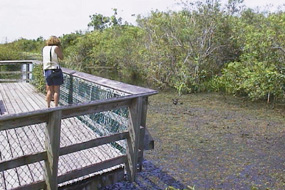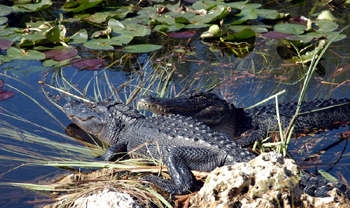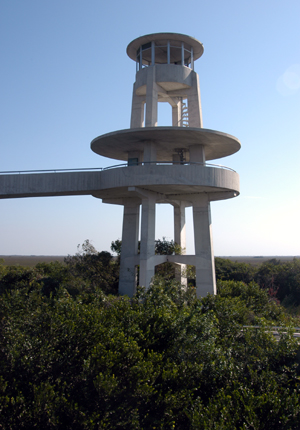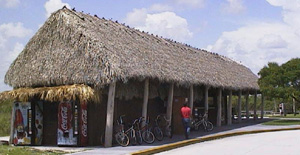
Rain shows visitors importance of water
SHARK VALLEY, Fla.— A 40-minute ride down U.S. 41 (Tamiami Trail) to the northern border of the National Everglades Park proved to be a knowledgeable and adventurous trip. Predicted rain showers from the weather forecast did not dampen the planned events of tourists as well as my planned tour of the Everglades.
Upon arrival I was met by motionless alligators lying on the edge of the water, active birds preying on their next meal, fish swimming around leaving behind a trial of bubbles in the water and surprised guest amazed at the habitat of the Everglades’ wildlife.
 |
There are plenty of photo ops at Shark Valley (Staff photos). |
These were sure signs that the dry season was approaching.
The only visible thing was the swampy marsh, which dominated the Everglades’ environment.
Many people crammed into the small quarters of the Visitor Center waiting for the sun to peak out beyond the smoggy clouds and gray sky. While waiting for that brief moment of sunlight, visitors indulged themselves in the books, exhibits, postcards and the information that was available in the Visitor Center.
Although it rained it was not a stumbling block, because this waiting period provided the rangers and the personnel of the park the opportunity to educate their guests about the wildlife existing in the freshwater ecosystem of the sawgrass marsh and tree islands known as the Everglades.
I traveled to the Shark Valley entrance of the park and the first stop was to the visitor center. However, in order to enter the park I had to pay an entrance fee of $8. Once I entered the park, I noticed that I could tour the park by bike, by tram, hiking or by walking. I decided to take a narrated two-hour tram ride for only $10.50.
“There are not many people visiting today due to the weather. On a sunny day there are about 500 people a day visiting the park. The people that have come to the park today, either do not care about the weather and are on vacation or they had no idea it would be raining like this,” Amanda Lahners, a seasonal park ranger, stated with a friendly smile.
The tram tour operates daily from 9 a.m. until 4 p.m. The early tours are on a first-come, first-serving basis. The tram tours begin at 2 p.m. and have to be reserved in order guarantee a seat. The tram tour stretches about 15 miles and it extends into the marsh with a guided narration by one of the park rangers.
“Shark Valley is the lifeline of the Everglades National Park. It is where it all begins,” Lahners said. “This is the most important part of the park and it allows the existence of the Everglades. Much of the wildlife that you will see here makes up about 80 percent of the park’s inhabitants. The first place to come when visiting the Everglades is Shark Valley.”
 |
Trams provide an easy way to see Shark Valley. |
While waiting for the tram to come back from its noon tour, I walked along the trail and saw a wading bird wrestling with its lunch. Of course, surprised visitors were snapping pictures with instant cameras and individuals were using tripods to keep their cameras still. I also saw nests located in trees with overprotective mothers guarding their young. Many people pointed as fish floated along the water leaving behind a path of bubbles.
“This swamp is like McDonald’s to these birds, because the water is filled with fish; therefore, making it easy to find food,” said Caroline Hendrickson, an Everglades volunteer who had on a crisp tan uniform with shorts and a ranger hat tied around her neck while walking along the trail. “People come to the park with an idea of what they may see, but once they go on the tour they come back with different perspectives of the Everglades.”
Along the 15-mile tour, we passed bikers that continuously stopped for the tram to pass. We passed people walking and pointing, and some people standing in awe because of what they had seen. The two cars passed four borrow pits (the pits are called borrow pits because the rocks that make up the pits were borrowed for construction purposes.)
 |
Two alligators relax in the sun near the Observation Tower at Shark Valley. |
During the tour, the Park Ranger Lahners informed her riders that there has been tremendous changes over the years in the trees and the sky.
She also discussed the difference between the dry season and the wet season. During the wet season it rains continuously, producing at least 60 inches of rain. During the wet season the mosquitoes emerge. The dry season is hot and has less water and many of the animals disappear to find remote large bodies of water to escape the shallow waters.
We are currently in the dry season. It is evident that the dry season has approached, because there was not much wildlife to view. The tour did find several alligators lying in the water and a couple of birds flying around to the different borrow pits. The most mundane sight on this tour was the rocks, swampy marsh and saw grass that make up the Everglades.
The ranger also made the effort to teach by sight. She asked the driver to stop the tram so that she could pick up several items from the ground for a session of show and tell.
The most interesting part of the two-hour tour was when the tram stopped for 15 minutes to allow the passengers the opportunity to go into the observation tower to view a large part of the Everglades at a high distance.
We also had the opportunity to scurry past two alligators lying in the walkway to the tower. The alligators rested lifelessly on the sidewalk and allowed the guest to walk by. The guest frantically shot close-up pictures of them, afraid that the alligators would move.
 |
The Observation Tower at Shark Valley rises above the park. |
“The tower is the best part of the tour, because I was able to view the park at a high distance and see an alligator close up,” said Matthew Richardson, a Canadian on vacation, as he videotaped the marshy grassland from the tower and the alligators lying in the walkway.
“Give the alligators room; otherwise, they will bite. They are not tamed. However, they will not bother you, if you do not bother them. If you plan to videotape or take pictures, please do so at a distance of 10 feet or more,” Lahners said.
It rained for majority of the tour, and many people covered themselves up with jackets and sweaters. Besides the rain there was the wind factor that made it feel colder than it already was. The tour was informative, but uncomfortable. If you were not prepared for the rain or the cold air than you may not have enjoyed the tour.
At 4 p.m. people jumped off the tram and headed back to the visitor center to buy souvenirs. I actually purchased a Shark Valley T-shirt to take back with me.
 |
The refreshment center at Shark Valley is housed in a traditional Indian chickee. |
“The tour was excellent. This was my first time at the park and I am surprised at what I saw. The only thing I disliked was the fact that I was not prepared for the rain and the cold air,” said Jamilah Johnson, an Orlando resident who toured the park for the first time.
The Everglades is the only place where alligators and crocodiles reside together, and it is rich in bird life. The Everglades has an extensive as well as impressive history and culture, and the only way to learn about the vast uniqueness of the Everglades is to take the time to visit. You can also gather information by reading books about the Everglades, but experience is the best teacher.
“If you want to learn about what the Everglades has to offer, you have to come see it in its entirety in order to understand its existence,” Hendrickson said as she walked away after watching a bird leap from a branch.
If You Go
- Weather: The Everglades is mild and pleasant from December through April. There may be occasional cold fronts in winter. In the summer, it is hot and humid with temperatures around 90 degrees. Afternoon thunderstorms are common and repellant is necessary for those pesky mosquitoes.
- Clothing: Clothing should be comfortable in the winter and loose fitting as well as provide some protection from being bitten by the abundance of mosquitoes during the summer. Do not forget to bring snacks and water to keep you occupied during the long visitation.
- Fees: The entrance fee is $8 and the ticket is valid for up to seven days. The $8 is per carload. The Everglades National Park annual pass costs $20.
- Reservations: Remember to call in advance to book a tram tour.
- Photo ops: A camera or a video camera would be necessary if you want to capture the beautiful sights of the Everglades on film.
- Tours: The tour is two hours long and there is a 15-minute break at the Shark Valley observation tower.
- Comfort: Wear comfortable shoes. Be prepared for the rain, heat, strong wind, or cold air.

Comments are Closed